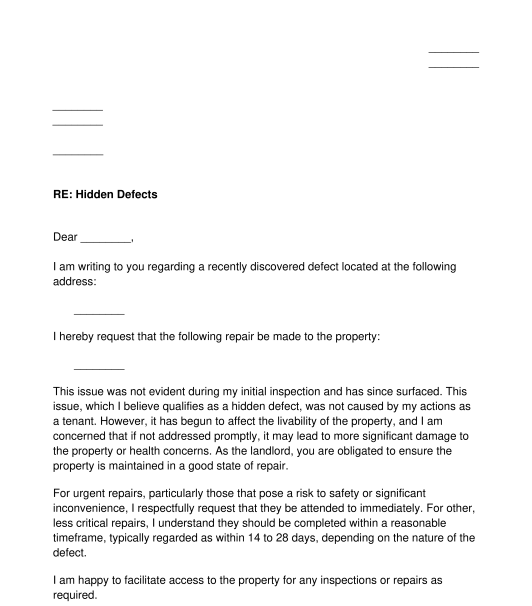 26/01/2025
26/01/2025

Answer a few questions and your document is created automatically.

Your document is ready! You will receive it in Word and PDF formats. You will be able to modify it.

 26/01/2025
26/01/2025
 Word and PDF
Word and PDF
 1 page
1 page
This Letter Reporting Hidden Defects in a Rented Property is for use in relation to residential properties. It serves as a formal communication from a tenant to their landlord to report hidden defects or issues that have been discovered in the rented property. It is a crucial document for tenants who encounter problems that were not initially apparent during their move-in inspection or have developed over time.
The letter outlines specific defects found in the property, such as plumbing issues, mold, electrical problems, or any structural damages that have come to light after the tenant has begun residing in the property. It serves as an official record of the tenant notifying the landlord about these issues, prompting necessary action for repairs or maintenance.
This document is intended for tenants who need to inform their landlords about hidden defects in the rental property. The letter should be addressed to the landlord or the property management company and should include the following:
Once the letter has been completed, it can be printed and signed by the tenant. It can then be mailed to the landlord, property manager, or maintenance person. Alternatively, it can be saved as a PDF and then emailed to the landlord, property manager or maintenance person.
It is a good idea for the tenant to keep a copy of the letter for his or her own records, and to make a note of the date that it was sent. This is especially important if the tenant is planning to use the letter to serve as a record that the landlord was made aware of the issue before the tenant took further action (such as by completing the repair themselves).
In addition, if the tenant is planning to use the letter to serve as a record that the landlord was made aware of the issue before the tenant took further action, then the tenant may need to consider who the letter is sent to. The lease might provide this information. For example, if the lease says that notices should be sent to the landlord, but the tenant has been dealing with a maintenance person directly, a copy of this letter should still go to the landlord (even if another copy goes to the maintenance person).
Tenants' rights, including minimum standards for maintenance of rental properties, are covered by Commonwealth and State laws. For more information about the relevant laws in a particular area, contact the local tenants union, tenancy help office, or community legal centre. If in doubt, seek legal advice.
You fill out a form. The document is created before your eyes as you respond to the questions.
At the end, you receive it in Word and PDF formats. You can modify it and reuse it.
Country: Australia